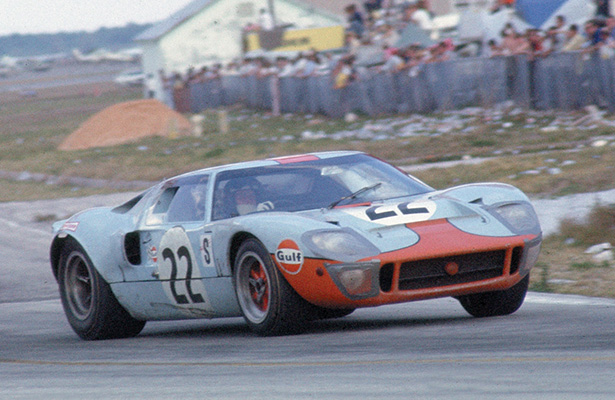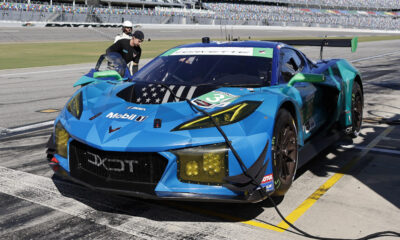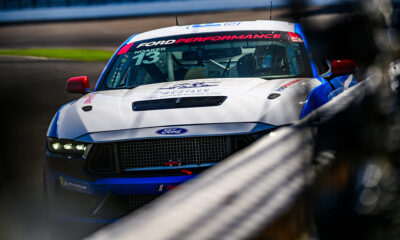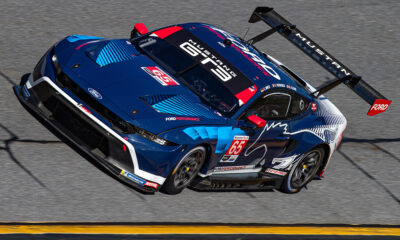
Photo: Sebring Archives
Sebring is known for the unexpected. Some of the most bizarre moments in endurance racing history have taken place at the historic circuit that originated from a WWII B-17 combat crew training base. We have chosen three races as perhaps the wildest ever: 1955, 1969 and the incredible 1983 race. In this second installment we’ll look at the 1969 Sebring 12 Hours.
Sebring 1970 is considered among the greatest in endurance racing history. Steve McQueen and Peter Revson nearly recorded an upset win in true “Hollywood” fashion.
Because of the legendary status of Sebring 1970, many people have forgotten that Sebring 1969 was probably a better race. If anything, it can be described as one of the wildest races ever, both on and off the track.
Woodstock took place at Max Yasgur’s farm in August 1969- an event that certainly marked an important moment in music and culture.
Big outdoor music festivals were all the rage in the late 1960s and early 1970s. Among them were several held at motorsports facilities such as the infamous Altamont festival in California (December, 1969) and the famous Summer Jam held at Watkins Glen in 1973.
In Florida, two different “Miami Pop Festivals” in 1968 (actually held in Hallandale at the Gulfstream Park horse track) attracted big crowds and a stellar lineup of musicians.
Jimi Hendrix headlined the first one in May, while the December festival’s lineup included the Grateful Dead, Fleetwood Mac, Marvin Gaye, Chuck Berry, Canned Heat, Joni Mitchell, Three Dog Night, Steppenwolf, Iron Butterfly… well, you get the point. It was a great time for music festivals. And it was a great time for sports car racing.
Sebring didn’t host a music festival in 1969, but the 12-hour classic had an atmosphere every bit as “festive.” Held during the traditional spring break for colleges, Sebring became the destination for college kids.
Notoriously cyclical sports car racing was reaching one of its peaks in 1969. The Sebring entry list was outstanding with great cars and a diverse lineup of drivers.
In addition, it was a time when virtually every kid identified with car culture. Whether it was American muscle cars, a little MG or a slot car set, American youth were infatuated with cars.
The favorite in the race was the Ferrari 312P driven by Mario Andretti and Chris Amon. They were the fastest qualifiers, breaking the track record. Porsche was a strong contender with four factory 908 entries and all-star cast of endurance drivers.
The Daytona-winning Penske Lola with Mark Donohue and Ronnie Bucknum was another favorite. Actor James Garner had two Lolas on the grid, and Alfa Romeo had three quick but unproven cars in the field.
The John Wyer Gulf Ford GT40 with drivers Jacky Ickx and Jack Oliver was considered somewhat of a darkhorse. The Ford GT40 was nearing the end of its competition life, and they barely qualified in the top ten. The clear favorites were Ferrari, Lola and Porsche
The year 1969 also marked the last ever “Le Mans start” at Sebring. It wasn’t a concert, but the sound of 70 race cars roaring to a start was music to the ears of this crowd. The “Woodstock of Auto Racing” was under way.
The early stages of the race saw a furious battle between the No. 31 Porsche of Brian Redman and Jo Siffert, the No. 9 Donohue/Bucknum Lola and the Andretti/Amon Ferrari. The Alfa Romeo team, meanwhile, saw all three of its entries retire during the first hour in a disastrous outing.
In Sebring’s Green Park spectator area, things were getting tense.
Since 1966 when electric cattle prods were used in an incident where fans were “not cooperating,” there was an antagonistic relationship between the younger fans and law enforcement. Remember this was the late 1960s when the counterculture movement was in full force. Confrontations between “college kids” and the local authorities were common.
And just when things couldn’t get any crazier, gangs showed up. Yes, gangs made an appearance at Sebring. There were motorcycle gangs and even “redneck gangs” such as the notorious Bartow Boys who made their presence known.
After a few minor confrontations with police, things started burning in Green Park- not to the extent of what would happen at The Bog in Watkins Glen five years later when a bus was burned to the ground, but it was an eerie scene at night with car headlights blazing around the circuit while flames and smoke could be seen in the spectator area.
Despite Sebring’s party reputation, the majority of spectators were dedicated race fans. They would not be disappointed with the on-track action.
And as usual, the tough 5.2-mile Sebring circuit began to wear teams down. One leader after another encountered mechanical problems. The Penske Lola retired with suspension failure.
Soldiering on methodically was the No. 22 Ickx/Oliver Ford GT. Slicing through the field, they had moved into fourth place after nine hours. Ahead of them were two factory Porsches and the Andretti/Amon Ferrari.
In the final two hours, the Ferrari was forced to pit with overheating problems and the two Porsches also had unplanned stops for suspension issues.
Taking the lead in the 11th hour, the No. 22 Ford crew watched nervously as they did not expect the car to last (the No. 23 sister car driven by David Hobbs and Mike Hailwood had retired early in the race).
The engine had been changed the night before so there was skepticism the car could survive the full distance.
But it was tires that caused the biggest concern in the final few minutes. Forced to pit for new tires, the Andretti/ Ferrari closed to within about 30 seconds of the lead, but then they encountered more overheating issues.
Ickx and Oliver held on for the upset win. The Andretti/Amon Ferrari finished second followed by the Porsche 908 of Kurt Ahrens, Rolf Stommelen and Joe Buzzetta.
Dick Smothers of the popular Smothers Brothers television show, a crowd favorite and an icon of the 1960s, captured a class win driving a Porsche 906E with Fred Baker. Smothers took a vocal anti-Vietnam War stance on his often controversial show, causing CBS to eventually cancel it.
Don Yenko and Bob Grossman won the GT class in a Chevrolet Camaro.
If an early DNF wasn’t bad enough for the Penske team, their Lola was stolen after the race when the transporter stopped near Daytona Beach for the night (most of the car was eventually recovered).
In November 1969, another pop festival took place in Florida, this time at Palm Beach International Raceway. The festival featured the Rolling Stones, Janis Joplin and Jefferson Airplane.
Like Woodstock three months earlier, it turned into a muddy mess and a traffic nightmare. The promoter lost thousands of dollars. Like the other music festivals of that era, it never took place again. But Sebring, the “Woodstock of Auto Racing,” is still going strong.


























